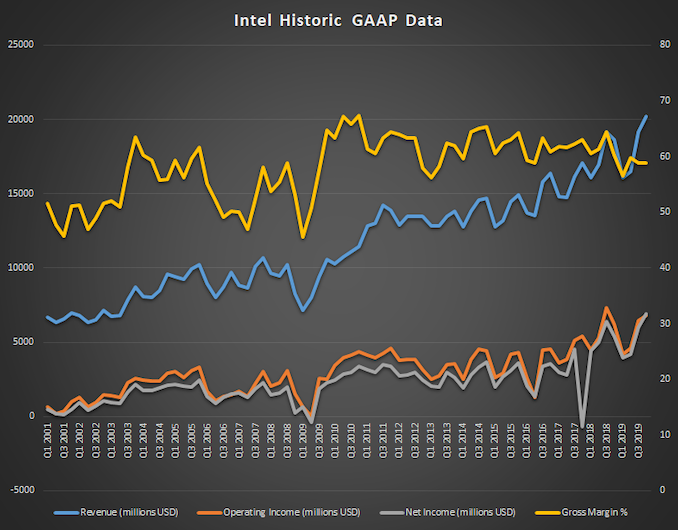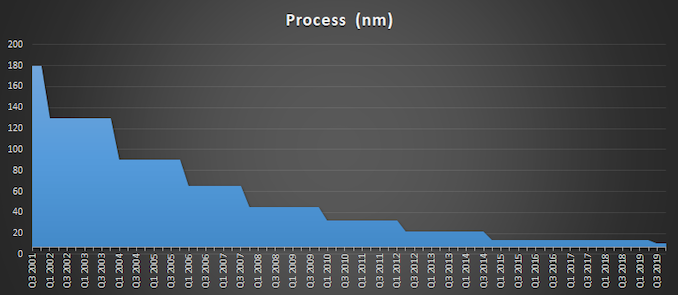Intel Q4 FY 2019 Results: Record Quarter, Record Year
by Brett Howse on January 23, 2020 8:45 PM EST- Posted in
- CPUs
- Intel
- Financial Results

Today Intel announced their earnings for the fourth quarter of their 2019 fiscal year. In terms of revenue, Intel had their highest ever Q4 revenue, coming in at $20.2 billion, and the full 2019 fiscal year, which was $72 billion. On a year-over-year basis, the results were up 8% and 2% respectively. Intel’s margins did slip a bit though, falling 1.4% to 58.8% of revenue. Operating income for the quarter was $6.8 billion, up 9% from last year, and net income was up 33% to $6.9 billion. This resulted in earnings-per-share of $1.58, up 40% from a year ago.
| Intel Q4 2019 Financial Results (GAAP) | |||||
| Q4'2019 | Q3'2019 | Q4'2018 | |||
| Revenue | $20.2B | $19.2B | $18.7B | ||
| Operating Income | $6.8B | $6.4B | $6.2B | ||
| Net Income | $6.9B | $6.0B | $5.2B | ||
| Gross Margin | 58.8% | 58.9% | 60.2% | ||
| Client Computing Group Revenue | $10.0B | +3% | +2% | ||
| Data Center Group Revenue | $7.2B | +12% | +19% | ||
| Internet of Things Revenue | $1.16B | +16% | +16% | ||
| Mobileye Revenue | $229M | +14% | +20% | ||
| Non-Volatile Memory Solutions Group | $1.2B | -7.7% | +10% | ||
| Programmable Solutions Group | $505M | flat | -17% | ||
Intel’s Client Computing Group, or CCG, had revenues of $10.0 billion for the quarter, up 2% from a year ago. Intel attributes the growth to modem sales and desktop platform volume. Intel is of course moving out of the 5G modem business, but will maintain its other connectivity offerings in the CCG such as their Wi-Fi products. Notebook platform volumes were down 1% in this quarter, with average selling prices staying flat, but desktop platform volumes were up 7%, but average selling prices fell 4%. Intel has said that they are expecting their chip shortage to be over by the end of this fiscal year.
Intel’s Data Center Group had revenue of $7.2 billion, up 19% from a year ago. Data Center sold 12% more unit volume this quarter than Q4 2018, and also added in 5% more average selling price per unit, so Intel’s DCG group is still very healthy.
Internet of Things, which include Mobileye, achieved revenue of $1.16 billion, up from $999 million a year ago. IoT was up 13%, accounting for $920 million of that revenue, and Mobileye was up 31% to $240 million.
Non-volatile Storage had revenue of $1.2 billion for the quarter, up 10% from a year ago which Intel is attributing to both NAND and Optane bit growth.
Programable Storage was the one area where Intel had a revenue drop, falling 17% year-over-year to $505 million, with no explanation given, but clearly FPGAs were in shorter demand.
Looking ahead to Q1 2020, Intel is expecting approximately $19.0 billion in revenue for the quarter, with earnings-per-share of $1.23.
Source: Intel Investor Relations












67 Comments
View All Comments
Amandtec - Thursday, January 23, 2020 - link
Ha ha ha AMD fanboys. Nobody cares about the performance. It is just about the sticker on the box!Irata - Friday, January 24, 2020 - link
I really hope this is a poor attempt at sarcasm. If not, do you realize how sad what you posted is?Makaveli - Friday, January 24, 2020 - link
I think his parents forgot to tuck him in and its way past his bedtime. The adults are speaking son run along.yetanotherhuman - Friday, January 24, 2020 - link
Certainly any OEM building a nice laptop thinks that.ksec - Friday, January 24, 2020 - link
Which is the thing I am not happy about AMD, Intel is still selling as much as they could make, to the point they are delaying all low margin product production and shift to higher margin DC chip.Comparatively speaking AMD's marketing and sales, as well as forecasting department are child's play compared to Intel.
Samus - Friday, January 24, 2020 - link
Personally I haven't built an AMD system in over a decade, because the last 3 I built all burned me one way or another. From flaky chipsets to buggy BIOSes to software compatibility issues to generally poor performance, yes I get that AMD is NOW making what is essentially a superior value in a number of segments, but the burn still itches the same way the only GM vehicle I had was such a turd I'll never own another GM product again.CiccioB - Friday, January 24, 2020 - link
Yes, reliability is something many kids forgot when deciding what to buy.Loosing a single work day because the BIOS/driver/compatibility creates issues is enough to make people, who WORKS WITH their PCs and do not simply play games or use a browser with it, buy the most reliable product vs the one that has 5% more performance in some selected benchmarks.
And guess who has constantly provided almost issue free systems in the last 10 years?
Carmen00 - Friday, January 24, 2020 - link
Is it the manufacturer that suffered most from Meltdown & Spectre?Opinion is great, but please, let's keep the facts in view.
Korguz - Friday, January 24, 2020 - link
carmen00, cicciob doesnt know how to do that.. going by is previous posts.. he is an intel fan boy all the way.. and just like a few others.. will do and say what he can to make intel seem and appear better... while posting little proof.. or where he gets his proofKorguz - Friday, January 24, 2020 - link
cicciob " And guess who has constantly provided almost issue free systems in the last 10 years? " you serious ?? like carmen said.. who has suffered the most from various bugs like meltdown and spectre ?? i read an article on that, which was linked to in another article on here, i think the count is something like 216 issues for intel, and 20 or less for amd. so who's more reliable ?? better yet, who's more secure ?????? to be fair.. i have had issues with both amd and intel cpus over the years. but keep praising your beloved intel cicciob...